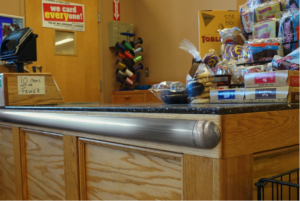
The selling area has long been the focus of retail damage prevention. It's where shoppers maintain the highest expectations for an attractive store environment while they distractedly propel their own carts into every exposed surface. Nowhere is the balance of aesthetics and damage prevention more critical than in the selling area. As the retailer, you are always looking to better protect this space, but where do you begin? I've worked with the McCue Bumper team to put together a buyers guide that will help you identify the most important criteria and features to consider when planning for protection in your selling area.
FIXTURE PROTECTION
No matter where your bumper is going, whether a fixture or the checkout area, one thing is certain—it must be strong. Bumpers are made from a wide variety of plastics, but PVC is the most common. McCue prides itself on using polycarbonate, the same material used to make bulletproof glass, football helmets, and riot shields. The grade of plastic resin determines the amount of impact and abrasion resistance a bumper can handle. Always be cautious and ask about what form of plastic a bumper provider uses before purchasing!
OTHER POINTS TO CONSIDER:
-
Point of impact (bumper is placed where impact will occur)
-
Strong and secure ends and corners (protects the most vulnerable part of the fixture)
-
Abrasion resistance (keeps bumper looking newer longer)
-
Shock absorbing design (insures that bumper will not shatter on impact)
-
Resign engineered for impact (insures bumper will not shatter or stress whiten when impacted)
-
Low coefficient of friction (helps to deflect impacts and facilitates traffic flow)
ENHANCING FIXTURE APPEARANCE
Different shapes, sizes, styles, and colors are available to match the décor and emphasize the brand of your store. Bumpers should be an extension of what they're protecting; they shouldn't stick out like a sore thumb. With that said, nothing sticks out more than a bumper that doesn't fit correctly, is mismatched, or is damaged. Curved surfaces require a flexible bumper with very different material attributes than a rigid bumper. Understand exactly what the object is that you are looking to protect, as well as what shape it is. A bumper expert will know to provide the right type of bumper based on the information you provide. Also, always be sure to ask your vendor whether the bumper will shrink and what to do if it does.
OTHER POINTS TO CONSIDER:
-
Consistent quality (ends and corners match lengths in color, gloss, and size)
-
Easy to clean (keeps store clean and sanitary)
-
Wide range of profiles and colors (enhances the fixture while providing protection)
-
Customizable (makes your bumper an extension of your brand and fixture)
IMPROVING OPERATIONS
Your time is valuable, and it shouldn't be spent running in circles repairing damages, dealing with injured shoppers, or creating DIY solutions for a broken fixture. Purchasing the right bumper for your store can cut expenses by reducing maintenance and repair costs. Who doesn't like the sound of that?
OTHER POINTS TO CONSIDER:
-
Extend the life of the store (keeps your store looking newer longer, without constant upkeep)
-
Reduce maintenance and repair costs (eliminate even worse destruction from a poor protection system; repairs can get costly)
-
Reduce liability costs from sharp edges (sharp edges can be a liability nightmare and also a hazard your shoppers won't appreciate)
-
Easy to install or replace (saves labor on installation and upkeep)



